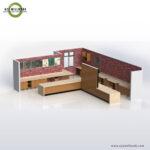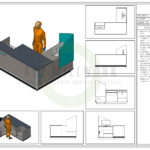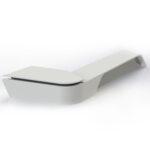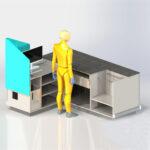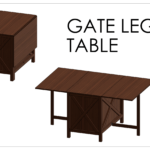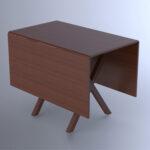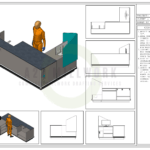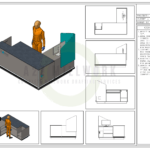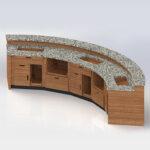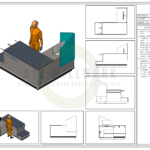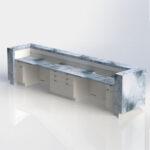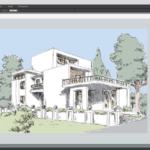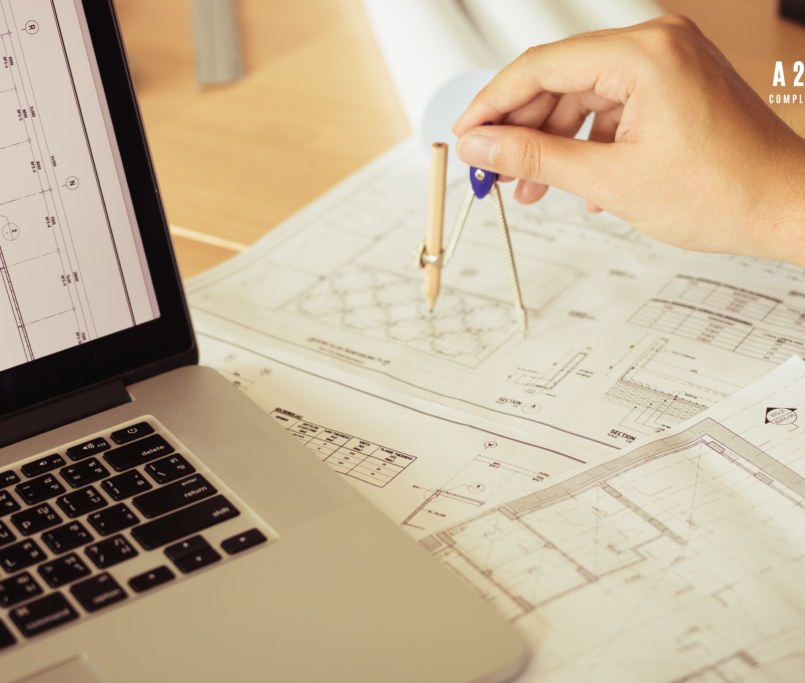Welcome to the world of 3D CAD drafting, where precision meets innovation and designs come to life with extraordinary accuracy. In this digital age, 3D CAD drafting, especially in the context of 3D AutoCAD shop drawings, has revolutionized the way we conceive, design, and fabricate intricate products and structures. From architects visualizing architectural marvels to manufacturers crafting complex machinery, this technology empowers professionals to create, analyze, and communicate with unprecedented clarity. Join us on this journey as we explore 3D AutoCAD shop drawing, Everything You Need to Know for modern design and manufacturing endeavors.
What is 3D CAD Drafting?
3D CAD (Computer-Aided Design) drafting is a digital design process that allows engineers, architects, and designers to create detailed, three-dimensional models of objects or structures. These models are built with intricate accuracy, mimicking real-world objects and enabling professionals to visualize, analyze, and test their designs before they become physical entities.
What are 3D AutoCAD Shop Drawings?
3D AutoCAD shop drawings are detailed representations of products or components, typically created for the manufacturing or construction process. These drawings provide crucial information about dimensions, materials, assembly instructions, and specifications. These drawings are pivotal in guiding manufacturers, builders, and fabricators in producing accurate and quality products.
The Evolution of CAD Drafting

The evolution of CAD drafting has been a remarkable journey, transforming the way we design, engineer, and create. It all began in the 1960s when the first computer programs aimed to assist in drafting emerged. These early systems, known as 2D CAD, allowed for basic drawing tasks, simplifying the drafting process but still constrained to flat, two-dimensional representations.
In the 1980s, 3D AutoCAD shop drawings emerged, marking a significant milestone. This advancement enabled designers and engineers to create three-dimensional digital models, providing a more realistic representation of objects and structures. This shift revolutionized the design process, allowing for better visualization and more comprehensive analysis of complex designs.
The 1990s brought about further improvements by integrating parametric modeling and more sophisticated user interfaces, making CAD software more accessible and user-friendly. As the 21st century unfolded, CAD drafting continued to evolve. Cloud-based CAD solutions enabled real-time collaboration among teams. At the same time, advancements in virtual reality (VR) and augmented reality (AR) technologies introduced new dimensions to the design review process, enabling users to interact with their CAD models in immersive ways.
Today, CAD drafting has become an indispensable tool across various industries, from architecture and engineering to product design and manufacturing. Its evolution continues as AI and machine learning are incorporated into CAD software, promising even greater efficiency, accuracy, and creative possibilities for designers and engineers in the future.
Applications of 3D CAD Drafting
3D CAD drafting is highly commended in the market for it’s ability to create detailed and realistic digital models that find a wide array of applications across industries. Regarding 3D AutoCAD shop drawings, the technology is pivotal in ensuring precision and accuracy in the manufacturing and construction processes. Let’s explore some of the primary applications:
Manufacturing and Fabrication
3D CAD drafting is essential for creating detailed shop drawings that guide the production process. Manufacturers use these drawings to define the products’ dimensions, materials, and assembly instructions. Whether a complex piece of machinery or a custom-fabricated component, 3D AutoCAD drawings help ensure that what’s built precisely matches the design.
Architectural Millwork
In architecture and interior design, 3D AutoCAD shop drawings are vital for crafting custom millwork items such as cabinets, doors, and windows. These drawings provide manufacturers with exact specifications, including joinery details and material choices, ensuring that architectural elements fit seamlessly into a building’s design.
Metal Fabrication
Metalworkers and fabricators use 3D CAD drafting to create detailed drawings for metal structures and components. These drawings guide the cutting, bending, welding, and assembly processes, contributing to the efficient production of metal products.

Cabinetry and Furniture Manufacturing
3D CAD drafting enables designers to create precise drawings for intricate pieces in cabinetry and furniture design. Manufacturers can then follow these drawings to craft customized furniture and cabinetry with the utmost accuracy.
Structural Steel Fabrication
3D AutoCAD shop drawings play a crucial role in fabricating structural steel components for the construction industry. These drawings provide information on the exact dimensions, welds, and connections, ensuring that steel structures fit together perfectly on-site.
Prefab Construction
In the realm of prefabricated construction, 3D CAD drafting is indispensable. Shop drawings guide the production of prefabricated components, allowing for faster and more efficient on-site assembly reducing construction timelines significantly.
Plumbing and HVAC Systems
Plumbers and HVAC technicians rely on 3D AutoCAD drawings to plan and install complex systems within buildings. These drawings provide precise pipe and duct routing details, ensuring optimal performance and functionality.
Benefits of 3D CAD Drafting
3D CAD drafting offers a plethora of benefits that significantly impact design, manufacturing, and construction processes. Let’s delve into these advantages:
Visualization
3D AutoCAD shop drawings provide realistic, three-dimensional representations of products or structures. This visualization capability enhances communication between designers, manufacturers, and clients, making understanding the final product’s form and function easier.
Precision
CAD software ensures high levels of precision and accuracy, reducing the risk of errors and costly revisions in shop drawings. Designers can specify exact measurements, tolerances, and material requirements, ensuring that the manufactured product meets the intended specifications.
Efficiency
The digital nature of 3D CAD drafting streamlines the design process. Changes and revisions can be easily made, saving time compared to traditional manual drafting methods. This efficiency is especially valuable in fast-paced industries like manufacturing and construction.
Collaboration
3D AutoCAD shop drawings facilitate collaboration among teams, whether they’re located in the same office or across the globe. Multiple stakeholders can simultaneously work on the same project, enabling better coordination and faster decision-making.
Cost Savings
Identifying and rectifying design flaws during the drafting stage is more cost-effective than addressing them during manufacturing or construction. 3D CAD drafting helps minimize errors and rework, resulting in substantial cost savings over the life of a project.
Quality Assurance
3D shop drawings help maintain quality control throughout the manufacturing or construction process by providing a comprehensive representation of the final product. Manufacturers can reference these drawings to ensure each component meets the required standards.
Customization
For industries like cabinetry, furniture, and architectural millwork, 3D CAD drafting allows for high customization. Designers can create shop drawings tailored to unique customer requirements, ensuring custom-made, one-of-a-kind products are produced.
Documentation
CAD software generates detailed documentation, which is invaluable for record-keeping and compliance. These documents can include materials lists, manufacturing instructions, and warranty information.
Simulations and Testing
Some CAD software includes simulation and testing capabilities, allowing engineers and designers to evaluate how a product or structure will perform under various conditions. This aids in optimizing designs for safety and functionality.
End
3D CAD drafting creates 3D AutoCAD shop drawings that have revolutionized the design and manufacturing industries. Its ability to provide precision, visualization, and collaboration has made it an essential tool for professionals across various domains. Whether designing a skyscraper, a new gadget, or a piece of furniture, 3D CAD drafting empowers you to bring your ideas to life accurately and efficiently. As technology advances, the future of CAD drafting holds even more exciting possibilities, pushing the boundaries of what can be designed and created.


